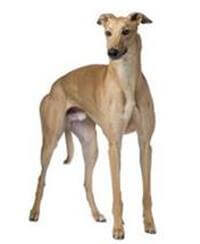Find products that match your dog’s needs

Looking to get yourself a family dog that is sweet and adorable? Meet the Greyhound, a breed known for their sleepy personalities but also for their agility and speed. When they are not cuddling or chilling, they are most probably out chasing squirrels and rabbits at crazy speeds. They love to laze around but they are also active, carrying almost no body weight.
Famously nicknamed as the “40 mph couch potatoes”, the Greyhound dog breed loves to lounge around the house and accompany its caregivers on leisurely walks. They make for ideal house pets and do not require a lot of grooming. While they are laid back in nature, they can also be an excellent partner for trails and hikes. If you’re looking for a dog that is ready to chill out with you while also being down to burn some calories, you have met your match.
Here are a few basic specifications of the Greyhound dog breed that every caregiver must be aware of before they welcome this floof home:
Weight | 26 to 32 kg |
Height | 27 to 30 inches |
Lifespan | 10 to 13 years |
Coat | Single coat |
These sleek and tall hounds carry almost no body fat and are known for their smooth fur. Greyhound’s natural coat is single-layered and short, and you will find them in different colours such as:
Red
Red brindle
Black
Blue
Blue brindle
Black brindle
White
White and black
White and red
White and blue brindle
Blue fawn
White and blue
White and black brindle
White and blue fawn
White and red brindle
While finding the above-mentioned range of Greyhound coat colours is common, if you ever come across a white-coloured Greyhound, it’s your lucky day. White-coloured Greyhounds are extremely rare and unique.
Greyhounds are often confused with Whippets because of their long narrow heads and muzzles. Whippets are also famously known as the small version of Greyhounds. If you are motivated to bring a purebred Greyhound home, look out for these physical features:
A Greyhound’s personality is all about relaxing and staying at ease. Hence, Greyhounds are famously known to be unbeatable as pets. They love hanging out with their caregivers and are not very difficult to manage. However, these mellow and calm dogs should not be your first choice for a guard dog.
Once you get a Greyhound dog home, it will need some time to get used to its new family and surroundings. It is important to be patient during this period. Once it gets used to its new setting, it will become your best friend. The Greyhound dog breed loves to get rid of its spurts of energy and once they’re exhausted, they will be one of the calmest beings. Unless you are a small animal such as a rabbit or squirrel, you have nothing to be scared of when it comes to a Greyhound. These dogs do well with other animals, but early socialisation plays a crucial role here. With proper socialisation, this breed can get used to a family setting and learn how to listen to their caregivers.
Yes, Greyhound dogs definitely need to be trained. While they are extremely calm and relaxed, they tend to be quite stubborn. Since they were bred to be independent and hunt alone, they follow their instinct and have trouble taking directions or following commands. As pet parents, all you need to do is be consistent and patient with their training and they will eventually learn how to understand and respond to commands.
The most common and important commands that Greyhounds need to learn are “sit” and “stay”. Since they love to chase things, these commands are usually the most difficult for them to follow. But when they do obey you, do not forget to shower them with delicious dog treats. Moreover, make sure to put your Greyhound on a leash during basic obedience training, just so they are easy to control. Additionally, Greyhounds can easily get bored; hence, keep the sessions short.
Greyhounds must also be socialised at an early age so that they can get along with other dogs and family members. You can take your Greyhound to a puppy obedience training class where it can not only learn to obey commands but can also make new friends.
Here’s everything you need to be aware of to make sure your Greyhound is healthy and thriving:
With a life expectancy of 10 to 13 years, this breed is generally healthy. But, just like all dog breeds, Greyhounds are also susceptible to different health issues such as gastric dilatation volvulus, blood clotting, cancer, back and joint issues, eye problems, and more. All deep-chested dog breeds are vulnerable to a deadly gastric disease known as bloat. Caregivers need to educate themselves about this disease so that they can identify its early signs and symptoms. Since this condition can be life-threatening, it is better to nip it in the bud. Visit a vet to learn more about health conditions that can affect your Greyhound’s well-being.
Greyhounds have a lovely single coat with really short fur which makes grooming for pet parents very easy. Since their coat is short, you can brush them every day without any inconvenience. Use a grooming glove or a hound mitt to brush your Greyhound.
One of the best things about the Greyhound dog breed is that they do not have that typical dirty dog smell. Which means, you do not need to worry about bathing your hound regularly. During summers you may need to bathe this breed more often, especially if it runs around in the open. But what about other occasions? Well, once or twice every month or two is enough.
Brush their teeth at least twice a week so there is no tartar build-up. Take it for professional teeth cleaning every year and nail trimming goes without saying. Every time you notice their nails clacking against the floor, it's time for a trim. Follow all these steps and you will have nothing to worry about.
Greyhounds love moving around and have a knack for speed. Every once in a while, they will want to get off their leash and just sprint around. Take your Greyhound out for 30 minutes each day and let it sprint around in a fenced environment. Fencing is necessary because these animals have an extremely high prey drive and can wander off very easily. Greyhounds are often referred to as the “cheetahs of the dog world” because of their speed. Thus, it is a no-brainer that they are ideal for active sports. Exercising their brain is important too. Give your Greyhound toys at home and reward it with its favourite dog treats every time it has been a good doggo.
Greyhounds have almost no body fat and a higher metabolic rate. For that reason, their diet needs to be high in calories and rich in protein. If your Greyhound is extremely active, you will need to pay extra attention to its diet. Greyhound parents need to opt for high-quality dog food formulated specially to meet this breed’s nutritional needs. To know exactly how much food your dog requires to maintain its health, consult a vet.
The origins of the Greyhound dog breed are rooted deep in history, ancient Egypt to be exact. Their pictures can be found in pyramids, and they were often mummified with their aristocratic families. During the Middle Ages, this breed was recognized as a trait of nobility and was also included in Renaissance painting as a sign of status and wealth. Throughout the years, this breed continued to gain the attention of many noblemen, became involved in different agility sports, and is now one of the most beloved family pets of all time.
Greyhounds have been around other dogs and creatures all their life, so yes, you can say that they get along really well with other pets. However, make sure to socialise with them from an early age.
A Greyhound is an excellent family dog that loves to cuddle with its caregivers. It also loves to accompany its pet parents on leisurely walks and relax with them.
Greyhounds can easily be left home alone for a few hours. However, leaving them alone for more than 6 to 8 hours may lead to boredom or make them anxious.
Greyhounds have a single coat with short fur which makes them extremely convenient to groom.
Greyhounds are quiet dogs and do not bark a lot. However, every dog is different and if your Greyhound is barking a lot, identify the underlying cause so that you can address it.

Find a PEDIGREE® stockist
near you!
Buy online
Click to buy from any of the retailers below

